The bright life of the MSX, Japan's underdog PC
How an 80s standard supported by Microsoft and Sony became Japan's most successful PC outside its home territory.
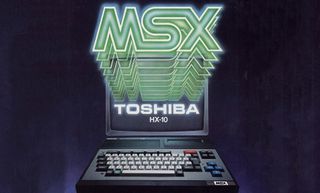
We're living in a personal computing golden age. As long as your PC sports decent hardware and a reasonably recent version of Windows, there's a good chance of being able to run almost every game out there. This was of course not always the case, with, at times in decades past, dozens of competing and completely incompatible personal computing formats vying for the attention of the few people who could afford a computer and actually wanted one in their homes.
Unfortunately, if you were buying into the promise of early personal computers and didn't choose one of the handful of leading platforms, or chose a platform that would soon be obsolete or orphaned, or even worse chose a platform that would never take off in the first place, you were pretty much stuck with an expensive doorstop.
A revolutionary idea took shape in this chaotic personal computer environment of the 1980s. What if instead of releasing just another computer platform into an overcrowded marketplace, there was a set of well-supported computer standards that would dictate software and hardware compatibility, regardless of manufacturer? That the was the dream of the MSX, organized by the Japanese arm of Microsoft.
It was an ambitious plan, and one that ultimately couldn't hold together for long. But for a while it worked, making the MSX the most popular Japanese PC ever outside its home country.
A global standard
Although there were earlier attempts at a personal computer standard, including systems based around the CP/M operating system, it was never comprehensive enough to include standards for hardware components. Of course, IBM PCs and Compatibles would eventually become a true standard, but through a good portion of the 1980s presented compatibility and technical limitations of their own before settling into more widely accepted standards that we're still benefiting from today. As such, the June 27, 1983, announcement of the MSX standard, which was the first to promise true hardware and software compatibility between any compliant computer model, seemed like a dynamite idea.
Unfortunately, the announcement wasn't necessarily well-timed, with the first systems based on the standard not finding their way to Japanese stores until later in the year, European stores in late 1984, and barely at all in North American stores. It was in the US's bigger market where low-end computing was in a particularly competitive price crunch. The capable and well-established Commodore 64 (released 1982) was already retailing for just $200 (about $485 today) right when the first Japanese systems were being made available.
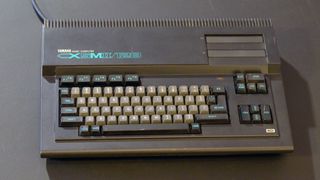
The primary MSX drivers were Microsoft, who even then was looking to be both the catalyst and beneficiary of a near universal computing standard, and ASCII, a Japanese publishing company who helped create Microsoft's first overseas sales office, ASCII Microsoft, in 1979. Over a dozen other (mostly Japanese) companies participated in the standard, including electronics giants like Canon, Casio, Pioneer, Panasonic, and Sony.
PC Gamer Newsletter
Sign up to get the best content of the week, and great gaming deals, as picked by the editors.
Despite what would eventually come to pass, with this type of powerhouse support, there was overwhelming optimism during the initial MSX announcement.
The base MSX specification was inspired by the technology found in Spectravideo SV-318/328 computers, which were released in June 1983. Although priced to sell and featuring competitive 16 color graphics, three channel sound, and a powerful Microsoft BASIC, Spectravideo’s computers soon joined the legion of low end computer systems that failed to gain a commercial foothold due to a dearth of compelling software and the popularity of competing systems. These competing systems included the aforementioned Commodore 64 in North America, and additional systems like the ZX Spectrum (1982) and Amstrad CPC (1984) in Europe.

MSX1
The initial MSX specification (now referred to colloquially as the MSX1), much like the original IBM PC, revolved around mostly proven, off-the-shelf components. The microprocessor was the 8-bit 3.58 MHz Zilog Z80A, whose variations were found in a variety of earlier computers, including the TRS-80 (1977) and ZX Spectrum. RAM started at 8K, but systems eventually topped out at 128K, although 64K remained the most popular, bringing it to parity with the Commodore 64.
The video chip was the 16K TMS9918, which supported a resolution of 256x192 in 16 colors (really 15 + 1 transparent) and whose variants powered a range of consoles and computers, including the Texas Instruments TI-99/4a (1981) and Coleco Adam (1983). The Adam was basically a 64K RAM version of the 1K ColecoVision (1982) videogame console, and proved to be yet another failed attempt at success in the low end computer market. While the TMS9918 was extremely competitive for its time, particularly in terms of color, there was no hardware support for scrolling. This limitation would often result in slow or choppy scrolling performance, or require additional restrictions in the number of colors or on-screen objects used.
The audio and basic I/O chip in the MSX1 was the General Instrument AY-3-8910, which supported three sound channels, and again helped power a wide range of other platforms, including many arcade machines, Mattel Intellivision (1979) consoles, and the aforementioned Amstrad CPC series. While three channels of sound doesn’t seem like much now, it was superior to many other systems of the time, including significantly more expensive Apple II and IBM PC computers.
As such, despite being based on the technological foundations of a short-lived Spectravideo computer series, the MSX standard was in good, well-established company in terms of its core functionality. And it allowed for what were known as standardized optional extensions, allowing manufacturers to add their own enhancements as long as they didn't interfere with any of the core standards, creating an opportunity for at least some product differentiation in what was hoped would be a crowded MSX computer market.
Early MSX games like Hudson Soft’s 1983 cartridge-based maze game Indian no Bouken (aka An Indian’s Adventure) had a similar look and feel to ColecoVision games thanks to their closely related architectures. In fact, today, games are regularly ported between MSX, ColecoVision, Sega SG-1000 (1983) console, and Memotech MTX (1983) computer platforms by talented homebrew programmers.
Although American magazines of the time like Electronic Games and Compute! did provide tentative coverage, occasionally paired with a clumsy headline categorizing the standard as a would-be "Japanese invasion," most editorial perspectives were relatively sober, acknowledging the many challenges such an initiative involved. In fact, from the initial 1983 announcement to as late as 1985, an editorial trend developed where MSX computers were regularly being touted as coming "right around the corner."
Some journalists reported that the more serious manufacturers were still assessing the viability of ever even entering the US market, which ultimately proved true. With the Commodore 64 dominating the low end of the US market, and previously established Atari (Atari 8-bit series, starting 1979) and Tandy (Color Computer series, starting 1980) computer lines already fighting over what little marketshare was left, meant that there was no room for a fledgling computer platform with similar capabilities and price point. And with a growing appetite for more expensive, but incredibly sophisticated 16-bit (and beyond) platforms like the Apple Macintosh (1984), Atari ST (1985), and Commodore Amiga (1985), as well as the continued rise and eventual dominance of PCs, the low end market would contract significantly as the latter part of the decade unfolded.
Despite the sometimes indifferent reaction from the American press, one particular aspect of the MSX standard did receive consistent praise, MSX BASIC (aka, MicroSoft eXtended BASIC, where some have claimed the MSX moniker originated). MSX BASIC was an extension of Microsoft BASIC 4.5 and patterned after BASICA/GW-BASIC, which was found on early IBM PCs and Compatibles. Besides featuring commands to access all of its sound and graphics features without resorting to the types of clumsy workarounds needed with other BASICs, MSX BASIC was consistently shown to be among the fastest of its contemporaries, including most Apple, IBM, Commodore, Tandy, and Atari computers.
MSX BASIC is what you normally see on startup without a cartridge inserted, but on some systems, like the Sony HB-75P, a PAL video-based model for the European market, there are additional programs to choose from in ROM.
The MSX2, MSX2+, and turboR Standards
The MSX2 standard, which came out in 1985, built on its predecessor's foundations, but added key improvements to the base RAM (64K - 512K), video memory (64K - 128K with higher resolution, more color, and support for vertical scrolling), and sound chip specifications. In 1988, the MSX2+ standard arrived, which among other improvements, raised the base video memory to 128K, with a maximum of 192K. Finally, the MSX turboR specification, which was set in 1990, added a new microprocessor, the R800 running at 7.16 MHz, more RAM (256K - 512K), additional sound chips, and a standard 3.5" floppy drive. MSX floppy disk systems, which consisted of both 5.25" and 3.5" models, ran MSX-DOS, which was based off the original PC-based MS-DOS disk system, used the same FAT12 file system, and allowed for read-write compatibility between the two platforms.
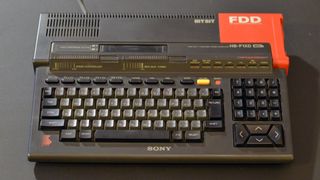
The Japanese Sony HB-F1XD was one of the more popular MSX2 computers and remains a popular acquisition target today. Special features include a dedicated PAUSE button that temporarily freezes the computer, a SPEED CONTROLLER slider that allows for various degrees of slow motion, and a REN-SHA TURBO slider that enables various degrees of auto-fire for joysticks and the spacebar. Besides the top-facing cartridge port, there is also a second cartridge port on the back of the unit. Dual cartridge ports were a popular feature on MSX computers, allowing for utility, sound, and memory expansion options to be used with a primary cartridge.
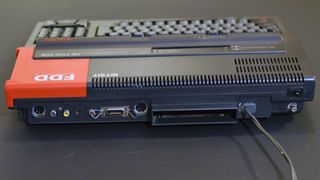
Unfortunately for MSX fans, with the introduction of each new standard, fewer and fewer manufacturers chose to introduce new models. This reached its apex in 1990, when only Panasonic chose to participate in the MSX turboR standard, releasing their FS-A1ST and FS-A1GT computers exclusively in Japan in 1991, and with their limited production runs ending just a few years later.
The games
As with many early personal computers with good graphics and sound capabilities, the MSX platform was home to a wide variety of games. Perhaps the most well-known MSX properties are two classic action-adventure stealth games from one of the platform’s more prolific supporters, Konami: Metal Gear (1987), and Metal Gear 2: Solid Snake (1990). Both games were targeted to the base MSX2 specification and were far superior designs to their vastly simplified, yet more high profile, Nintendo Famicom/NES counterparts.
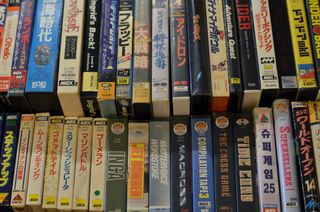
While the MSX platform is home to every type of game genre, including RPGs, strategy games, and adventure games, they're often time intensive and heavy on Japanese text, limiting their accessibility to non-native speakers. As such, what follows are a sampling of five great, accessible MSX series games with limited Japanese text that originated on the platform and are well worth checking out:
Golvellius (Compile, 1987)
This MSX1 cartridge game, known as Maou Golvellius (aka, Devil Golvellius) in Japan, is an action adventure similar to The Legend of Zelda (Nintendo, 1986, Famicom), where exploration and discovering helpful items are just as important as monster busting skills. For more action-adventure fun, check out its MSX2-powered remix from 1988, Shin Maou Golvellius (aka, True Devil Golvellius), and spin-off, Super Cooks (1989), part of the Disc Station Special 2 – Summer Edition game compilation, which came on five 3.5” floppy disks.
King's Valley II: The Seal of El Giza (Konami, 1988)
Found in both MSX1 and MSX2 (pictured) cartridge versions, maze game platformer King's Valley II is the sequel to King’s Valley, which saw release on MSX1 computers in 1985. The MSX2 version is largely the same as the MSX1 version, save for minor differences like a higher resolution and larger color palette, but makes for a better overall experience if you have a system that supports it.
Mr. Ghost (System Sacom, 1989)
This MSX2 cartridge game, known as Yuureikun in Japan, is notable for deftly combining platforming elements with the mechanics of a shoot 'em up, alternating between side and vertical scrolling. For another interesting take on the platformer genre, check out the MSX2 cartridge exclusive, Vampire Killer (Konami, 1986), a more exploration-heavy entry in the popular Castlevania action-adventure series.
Penguin Adventure (Konami, 1986)
This MSX1 cartridge game, known as Yume Tariku adovenchā (aka, Dream Continent Adventure) in Japan, is the much-improved sequel to the more well-known Antarctic Adventure (Konami, 1984), which saw release on MSX1, ColecoVision, and Famicom platforms. While still a quirky racing game at heart, Penguin Adventure adds greater stage variety, boss fights, purchasable items, and mini-games to its predecessor’s formula.
Space Manbow (Konami, 1989)
This MSX2 cartridge-based shooter was made exclusively with the platform in mind, and it shows. Smooth scrolling and detailed, colorful graphics complement the well-designed gameplay. Another superior shooter worth checking out for MSX2 systems is Aleste 2 (Compile, 1989), which comes on a single 3.5” floppy disk.
The present and future
Success in various smaller markets like Brazil and Argentina in South America, continental European countries like the Netherlands and Spain, and Arab countries like Saudi Arabia and Kuwait, aside, the MSX standard proved a mostly Japanese phenomenon. It never approached the success of its better known brethren in its home country: NEC (PC-8800 series, 1981, and PC-9800 series, 1982), Fujitsu (FM series, 1981), and Sharp (X1 series, 1982, and X68000 series, 1987) all beat the MSX in mind- and market-share.
But the combined MSX series still is said to have sold over seven million units in Japan alone, with another two million units in other territories. In fact, of the many other home-grown Japanese computer platforms, none ever made it to anywhere near the number of other territories that MSX did.
With its estimated nine million units sold and nearly a decade in various markets, it's no surprise then that the MSX platform still has plenty of fans today. Besides popular fan sites like The MSX Resource Center and quality emulators like blueMSX, openMSX, and fMSX, dedicated homebrew developers continue to make new hardware and software that work on the original computers. Outside of the countless new games, other modern day creations include memory expansions, audio expansions, and flash memory devices for running software without the need for the original cartridge, disk, or cassette tape.
As with any good vintage platform, the MSX lives on 30 years later thanks to the ongoing passion of its most dedicated fans.
Most Popular

